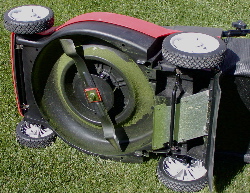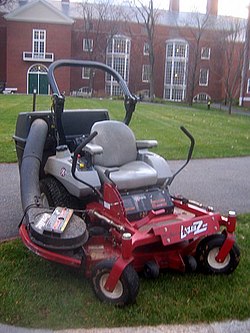



A lawn mower (also known as a grass cutter or simply mower, also often spelled lawnmower) is a device utilizing one or more revolving blades (or a reel) to cut a grass surface to an even height. The height of the cut grass may be fixed by the mower's design but generally is adjustable by the operator, typically by a single master lever or by a mechanism on each of the machine's wheels. The blades may be powered by manual force, with wheels mechanically connected to the cutting blades so that the blades spin when the mower is pushed forward, or the machine may have a battery-powered or plug-in electric motor. The most common self-contained power source for lawn mowers is a small 4-stroke (typically one-cylinder) internal combustion engine. Smaller mowers often lack any form of self-propulsion, requiring human power to move over a surface; "walk-behind" mowers are self-propelled, requiring a human only to walk behind and guide them. Larger lawn mowers are usually either self-propelled "walk-behind" types or, more often, are "ride-on" mowers that the operator can sit on and control. A robotic lawn mower ("lawn-mowing bot", "mowbot", etc.) is designed to operate either entirely on its own or less commonly by an operator on a remote control.
Contents
- History
- Invention
- Further improvements
- Atco Ltd and the first motor mower
- Rotary mowers
- Types
- By rotation
- By energy source
- Other notable types
- Safety issues
- Environmental and occupational impact
- See also
- References
- Further reading
- External links
Two main styles of blades are used in lawn mowers. Lawn mowers employing a single blade that rotates about a single vertical axis are known as rotary mowers, while those employing a cutting bar and multiple blade assembly that rotates about a single horizontal axis are known as cylinder or reel mowers (although in some versions, the cutting bar is the only blade, and the rotating assembly consists of flat metal pieces which force the blades of grass against the sharp cutting bar).
There are several types of mowers, each suited to a particular scale and purpose. The smallest types, non-powered push mowers, are suitable for small residential lawns and gardens. Electrical or piston engine-powered push-mowers are used for larger residential lawns (although there is some overlap). Riding mowers, which sometimes resemble small tractors, are larger than push mowers and are suitable for large lawns. However, commercial riding lawn mowers (such as zero-turn mowers) can be "stand-on" types and often bear little resemblance to residential lawn tractors, being designed to mow large areas at high speed in the shortest time possible. The largest multi-gang (multi-blade) mowers are mounted on tractors and are designed for large expanses of grass such as golf courses and municipal parks, although they are ill-suited for complex terrain.



















